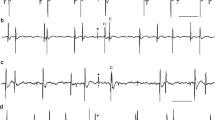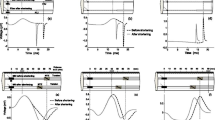Abstract
Spike discharges of skeletomotor neurons innervating triceps surae muscles elicited by white noise modulated transmembrane current stimulation and muscle stretch were studied in decerebrated cats. The white noise modulated current intensity ranged from 4.3 to 63.2 nA peak-to-peak, while muscle stretches ranged from 100 μm to 4.26 mm peak-to-peak. The neuronal responses were studied by averaging the muscle length records centered at the skeletomotor action potentials (peri-spike average, PSA) and by Wiener analysis. Skeletomotor spikes appeared after a sharp peak in PSA of the injected current, preceded by a longer-lasting smaller wavelet of either depolarizing or hyperpolarizing direction. The PSA amplitude was not related to the injected current amplitude nor showed any differences related to the motor unit type. The PSA amplitudes were virtually independent of the stretching amplitude σ, after an initial increase with stretching amplitudes in the range of 15–40 μm (S.D.), or 100–270 μm peak-to-peak.
Analyses of cross-spectra indicated a small or absent increase in gain with frequency in response to injected current, but about 20 dB/decade in the range 10–100 Hz in response to muscle stretch. The peaks of both Wiener kernels in response to current injection appear to decrease with the amplitude of injected current, but this decrease was not statistically significant. The narrow first-order kernels suggest that the transfer function between the current input and spike discharge is lowpass with a wide passband, i.e. there is very little change in dynamics. The values of the second-order kernels appear to be nonzero only along the main diagonal. This is characteristic of a simple Hammerstein type cascade, i.e. a zero memory nonlinearity followed by a linear system. Small values of second-order kernels away from the origin and narrow first-order kernels suggest that the linear cascade contributes very little to the overall dynamic response.
In contrast to Wiener kernels found in response to current injection, the Wiener kernels in response to stretch showed a decreasing trend with stretch amplitude. The size of the second-order kernels decreased to a somewhat larger extent with input amplitude than that of the first-order kernels, indicating an amplitude-dependent nonlinearity. Overall, the transformation between length and spike output was described as an LNNL cascade with second-order nonlinearities.
Similar content being viewed by others
References
Anastasijevic R (1976) Reflex activity of spinal neurons elicited by adequate proprioceptive stimulation. Doctoral thesis, Beograd
Anastasijevic R, Anojcic M, Todorovic B, Vuco J (1968) The differential reflex excitability of alpha motoneurones of decerebrate cats caused by vibration applied to the tendon of the gastrocnemius medialis muscle. Brain Res 11:336–346
Anastasijevic R, Anojcic M, Todorovic B, Vuco J (1969) Effect of fusimotor stimulation on the reflex response of spinal alpha motoneurones to sinusoidal stretching of the muscle. Exp Neurol 25:559–570
Anastasijevic R, Jovanovic K, Ljubisavljevic M, Vuco J (1991) Time coupling of skeletomotor discharges in response to pseudo-random transsynaptic and transmembrane stimulation. Biol Cybern 64:321–328
Anojcic M, Pasic M, Todorovic B, Vuco J (1967) The reflex activity of spinal motoneurons under dynamic conditions of stretching the tendon to triceps surae muscle in cats. Yugosl Physiol Pharmacol Acta 3:109–121
Anojcic M, Pasic M, Todorovic B, Vuco J (1968) The reflex activity of spinal alpha motoneurones under dynamic conditions of stretching the tendon to triceps. J Physiol 194:30–33
Baldissera F (1984) Impulse frequency encoding of the dynamic aspect of excitation. Arch Ital Biol 122:43–58
Baldissera F, Campadelli P, Piccinelli L (1982) Neural encoding of inputs transients investigated by intracellular injection of ramp currents in cat α-motoneurones. J Physiol 328:73–86
Baldissera F, Campadelli P, Picinelli L (1984) The dynamic response of cat α-motoneurones investigated by intracellular injection of sinusoidal currents. Exp Brain Res 54:275–282
BoskovD, Jocic M, Jovanovic K, LjubisavljevicM, Anastasijevic R (1992) Spike discharges of skeletomotor neurones in response to current injection and pseudorandom stretching of the triceps surae muscles in decerebrate cats. Eighth BMSR Workshop on Nonlinear Methods in Physiological System Modeling, Marina del Rey, Calif
Bryant HL, Segundo JP (1976) Spike initiation by transmembrane current: a white noise analysis. J Physiol 260:279–314
Fetz EE, Gustafsson B (1983) Relation between changes of post-synaptic potentials and changes in firing probability of cat motoneurone. J Physiol 341:387–410
Granit R, Haase J, Ruthledge LT (1960) Recurrent inhibition in relation to frequency of firing and limitation of discharge rate of extensor motoneurones. J Physiol 154:308–328
Granit R, Kernell D, Shortess GK (1963) Quantitative aspects of repetitive firing of mammalian motoneurones, caused by injected currents. J Physiol 168:911–931
Grüsser O-J, Thiele B (1968) Reaktionen primärer und sekundärer Muskelspindelafferenzen auf sinusförmige mechanische Reizung. I. Variation der Sinusfrequenz. Pflügers Arch 300:161–184
Gustafsson B (1984) Afterpotentials and transduction properties in different types of central neurones. Arch Ital Biol 122:17–30
Gustafsson B, McCrea D (1984) Influence of stretch-evoked synaptic potentials on firing probability of cat spinal motoneurones. J Physiol 347:431–452
Homma S, Kanda K (1973) Impulse decoding process in stretch reflex. In: Gydikov AA, Tankov NT, Kosarov DS (eds) Motor control. Plenum Press, New York, pp 45–64
Hung G, Stark L, Eykhoff P (1977) On the interpretation of kernels. I. Computer simulation of responses to impulse pairs. Ann Biomed Eng. 5:130–143
Kearney RE, Hunter IW (1983) System identification of human triceps surae reflex dynamics. Exp Brain Res 51:117–127
Kearney RE, Hunter IW (1988) Nonlinear identification of stretch reflex dynamics. Ann Biomed Eng 16:79–94
Kernell D (1965a) The adaptation and the relation between discharge frequency and current strength of cat lumbosacral motoneurones stimulated by long-lasting injected currents. Acta Physiol Scand 65:65–73
Kernell D (1965b) The limits of firing frequency in cat lumbosacral motoneurones possessing different time course of afterhyperpolarization. Acta Physiol Scand 65:87–100
Korenberg MJ, Hunter IW (1986) The identification of nonlinear biological systems: LNL cascade models. Biol Cybern 55:125–134
Korenberg MJ, Sakai HM, Naka K-I (1989) Dissection of the neuron network in the catfish inner retina. II. Interpretation of spike kernels. J Neurophysiol 61:1110–1120
Kostyukov AI, Kryzhanovsky MV (1982) Impulse activity evoked in the cat spinal neurons by sinusoidal depolarizing currents. Neurofiziologiya 14:B35-B42
Kröller J, Grüsser O-J, Weiss L-R (1985) The response of primary muscle spindle endings to random muscle stretch: a quantitative analysis. Exp Brain Res. 61:1–10
Kröller J, Grüsser O-J, Weiss L-R (1988) Observations on phase-locking within the response of primary muscle spindle afferents to pseudo-random stretch. Biol Cybern 59:49–54
Lüscher HR, Ciamann HP (1992) Relation between structure and function in information transfer in spinal monosynaptic reflex. Physiol Rev 72:71–99
Marmarelis PZ, Marmarelis VZ (1978) Analysis of physiological systems. The white noise approach. Plenum, New York, pp 21–32
Retaking RM, Stephens JA, Stuart DG (1975) The tendon organs of cat medial gastrocnemius: significance of motor unit type and size for the activation of Ib afferents. J Physiol 250:491–512
Schwindt PC, Calvin WH (1972) Membrane-potential trajectories between spikes underlying motoneurone firing rates. J Neurophysiol 35:311–325
Soechting JF, Dufresne JR (1980) An evaluation of nonlinearities in motor output response to applied torque perturbations in man. Biol Cybern 36:63–71
Van Keulen L (1981) Autogenetic recurrent inhibition of individual spinal motoneurones of the cat. Neurosci Lett 21:297–300
Westbury DR (1971) The repsonse of α-motoneurones of the cat to sinusoidal movements of the muscles they innervate. Brain Res 25:75–86
Author information
Authors and Affiliations
Rights and permissions
About this article
Cite this article
Boskov, D., Jocic, M., Jovanovic, K. et al. Spike discharges of skeletomotor neurons during random noise modulated transmembrane current stimulation and muscle stretch. Biol. Cybern. 71, 341–348 (1994). https://doi.org/10.1007/BF00239621
Received:
Accepted:
Issue Date:
DOI: https://doi.org/10.1007/BF00239621




